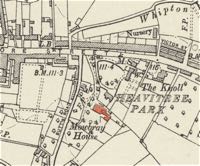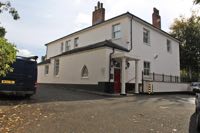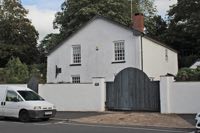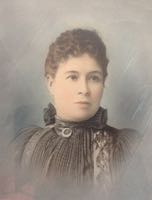
Mowbray House
Formerly Wonford Hill House
Page updated 6th October 2017
 The multi occupancy, Mowbray House in Heavitree–there was also a similarly named house in St David’s Hill–will be remembered fondly by many mothers, as the place where there gave birth to their children, and equally, many adults will think of it as their birthplace. However, for more than a hundred years the house was a private residence.
The multi occupancy, Mowbray House in Heavitree–there was also a similarly named house in St David’s Hill–will be remembered fondly by many mothers, as the place where there gave birth to their children, and equally, many adults will think of it as their birthplace. However, for more than a hundred years the house was a private residence.
Captain James Tillyer Blunt of the East India Company’s Bengal Engineers purchased a field off Fore Street, Heavitree, at the junction with Butts Road, in 1816, and built himself a fine house. Named Wonford Hill, he settled in with his wife, in retirement. Tillyer died in 1834, and was buried in the churchyard of Heavitree Church. His wife Mary continued to live in the house until her death in June 1849, when the house was left to their son Richard Tillyer Blunt, who married in 1857.
An attempted murder at the house took place in November 1856, as a result of, a poster was circulated bearing the following:
“ATTEMPTED MURDER.-A bill bearing the above heading has been circulated in this city. It offers a reward of £10O to any person who shall give such information as will lead to the conviction of some person or persons who on Friday last, the 14th, did violently threw several large stones against the window of a bedroom of the dwelling-house of Richard Tillyer Blunt, Esq., of Wonford-hill, Heavitree, while the proprietor was in London, and did thereby break the window shutters and glass of the said window, and did seriously alarm, injure the health, and endanger the life of an invalid lady in the said room. It was considered that the outrage was designed with a view of causing the death of the lady. Information must be given to Woodbury, the Heavitree constable, and the reward will be paid on a conviction taking place.”
Tillyer Blunt was vice president of the Institution for the Blind, and would entertain teachers and pupils at his house. In 1871 an advert appeared requesting anyone who had a claim on the estate of Margaret Blunt to contact Richard Tillyer of Wonford Hill. Richard Tillyer died in November 1875.
While in the occupation of Mr Havill, the house was advertised for sale by auction in May 1886. It was described thus:
“… all that Freehold Mansion-like Messuage or Tenement called WONFORD HILL HOUSE and LANDS, comprising an excellent DWELLING-HOUSE, standing in its grounds of about three acres and three roods, with conservatories, extensive lawns and gardens, greenhouses, hothouses, orchard, piece of pasture land, together with other lands, in the occupation of Mr. Havill, containing about nine acres, two roods, and 25 poles, altogether making a total of 13a. 1r 25p.
The Dwelling-house contains dining-room, 20ft. by 17ft.; drawing-room, 26½ft. by 17½ft.; breakfast-room, 17½ft. by 10½ft.; library, 17ft. by 10ft.; 8 bedrooms, man servant's room, 2 w.c.'s, kitchen and other offices, coachhouse and stable, yards, and outbuildings.”
The house was up for auction again in October 1887 when it was sold by the mortgagees for £3,600. This was when it was renamed Mowbray House. The next to live in the house, of note, was Lieutenant-Col Edward Hensman Vaughan, MB who returned from the front in South Africa in December 1900. He was welcomed back by residents and the Heavitree Fire Brigade who “after unhorsing the vehicle, Lieutenant Vaughan, and his mother and father were drawn to Mowbray House.”
Colonel Vaughan put the house up sale in June 1909, with a reduced area of land of three acres from the original thirteen acres in the sale of 1886. It transpired that it did not reach the asking price. The next owner of Mowbray, Mr A Wise, lived there for about a year, before he vacated the house to live in the Channel Islands—its contents were auctioned in February 1911.
Two months later, the house was sold to Mr Toll of Surbiton, for £2,000. It was not a good move for Mr Toll, as there was a fire in an end gable in April 1912. P S Mortimore broke into the stable and led the horse to a safe place. P C Weeks fetched buskets of water for the sergeant to throw over the fire, in the hay loft. The fire brigade arrived, and coupled up a thousand feet of hose to fight the fire. Things got worse for Mr Toll, for he died in November 1912. It remained a private house through the First War.
Home Hospital
It was announced in December 1921, that the Home Hospital, at Mount Radford, was to relocate to Mowbray House. The hospital, run by Miss Hunter, Matron, and her partner Miss Biggs, would have beds for twelve patients, and had a theatre and sterilising room installed, for the use of local physicians and surgeons. It was decorated in chocolate and white, and a great virtue was made of the building having electricity. It catered for the wealthy of Devon—The Earl of Iddesleigh had an operation on one of his eyes in 1924. By 1930, the rural aspect of the area was being lost as Butt’s Lane and the nearby Burnthouse Estate were developed.
Maternity Home
Mowbray House became the Municipal Maternity Home for Exeter, which was run by the Exeter & District Nursing Association by arrangement with the city council. It was still run by Miss Hunter. By October 1939, the home was full of mothers and babies, including evacuees. The Bishop of Exeter and his wife visited the hospital in December 1939. Judging by the number of notices for births in the newspapers, Mowbray House was busy throughout the war.
A fete was held at the house in June 1943 when the Countess of Devon visited. She remarked “A lot of people to-day tell us is not patriotic, it is not wise, to have babies in wartime, I don't agree with them at all. because I feel that it we have not enough faith in the future to bring more lives into the world which we are fighting so hard to improve. what is the use of fighting at all? Our babies are a pledge for the future and are a sort of hostages to prove our desire not only to make the world better, but when peace comes to make it a peace really lasting and worth having." The fete was in aid a fund to provide a wireless set with loud speakers for the use patients and the domestic and nursing staffs. Gwendoline Pate, aged four years, the daughter of Mr. and Mrs. F. J. Pate, of Old Brewery-place, St Thomas, was the first baby to be born in the home. She presented the Countess of Devon with a box of chocolates.
By the end of the war, the Maternity Home was having problem with finding sufficient staff for the eighteen beds. In August 1946 the lack of staff threatened the reduction of beds to eight, and maybe even closure. The problem was both recruiting domestic staff and midwives. They needed three midwives and two to three auxiliaries to add to the Matron, a single midwife and auxiliary nurse. In the event, the maternity home did not close and in 1948 it was absorbed into the Mid-Devon area for the newly formed National Health Service.
Mowbray House served Exeter as a maternity home as part of the NHS from the 1940s through to the 1980s, and thousands of babies were born within its walls.
The house became the Exeter School of Nursing after the maternity unit closed, in March 1986. The existing school of nursing at Wonford was demolished to make way for the Royal Devon and Exeter, Wonford. Nurse training continued at Mowbray until it moved to the University of Plymouth buildings at the old art college near Ducks Marsh in the mid 1990s. Now all nurse training is now at Plymouth.
The house was converted into retirement flats, and in 2001, the adjoining Mowbray Court was constructed.
Sources: The British Newspaper Archive (Flying Post, Exeter and Plymouth Gazette and the Western Times). Discovering Exeter No 3 Heavitree by Trevor Falla.
│ Top of Page │



